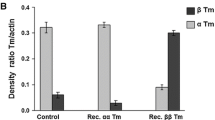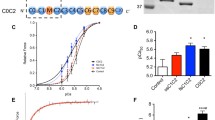Summary
Tetrodotoxin (TTX), at concentrations that do not interfere with normal myogenesis or with myosin synthesis, causes failure of cultured muscle fibres to accumulate myosin heavy chain peptides. This effect is now shown to be reversible. On removal of TTX, muscle fibres begin to reaccumulate myosin heavy chains and it appears that the myosin heavy chains display a 230% increase in stability when cells are shifted from TTX to a normal medium without TTX. Total protein stability or turnover is not affected by TTX. The ability of TTX to induce failure of accumulation of myosin heavy-chain in cultured muscle fibres does not extend to cultured chick fibroblasts. TTX also does not perturb normal uptake of [3H]leucine during a 1 h pulse and the leucine-specific activity within TTX-treated cells is essentially equivalent to that within normal cells. Finally, limited proteolysis of myosin heavy chain isolated from TTX-treated and normal muscle fibres and display of cleavage products on SDS-polyacrylamide gels does not reveal any significant difference between the two myosins. We conclude that failure of TTX muscle to accumulate myosin heavy chain is not related to impaired synthesis, to changes in myosin heavy-chain primary structure, or to overall changes in muscle fibre proteolytic activity. We speculate that the increase in degradation and resulting failure to accumulate myosin heavy chain in TTX cells is related to an inability of TTX-related muscle fibres to assemble newly synthesized fibrillar proteins into structures such as filaments or fibrils. Failure of assembly would lead to increased exposure to base-line levels of muscle proteolysis and to the observed lack of accumulation of myosin heavy chain.
Similar content being viewed by others
References
BONNER, W. M. & LASKEY, R. A. (1974) A film detection method for tritium labelled proteins and nucleic acids in polyacrylamide gels.Eur. J. Biochem. 46, 83–8.
BOSSHARD, H. F. & DATYNER, A. (1977) The use of a new reactive dye for quantitation of prestained proteins on polyacrylamide gels.Analyt. Biochem. 83, 327–33.
BRADFORD, M. (1976) A rapid and sensitive method for the quantitation of microgram quantities of protein utilizing the principle of protein-dye binding.Analyt. Biochem. 72, 248–52.
CATTERALL, W. A. (1980) Pharmacologic properties of voltage-sensitive sodium channels in chick muscle fibers developingin vitro.Devl Biol. 78, 222–30.
CLEVELAND, D. W., FISCHER, S. G., KIRSCHNER, M. W. & LAEMMLI, V. K. (1977) Peptide mapping by limited proteolysis in sodium dodecyl sulfate and analysis by gel electrophoresis.J. biol. Chem. 252, 1102–6.
COHEN, S. A. & FISCHBACH, G. D. (1973) Regulation of muscle acetylcholine sensitivity by muscle activity in cell culture.Science 181, 76–8.
FISCHBACH, G. D. & NELSON, P. G. (1977) Cell culture in neurobiology. InHandbook of Physiology — The Nervous System (edited by KANDEL, E. R.), Vol. I, Part 2, pp. 719–774. Bethesda, Maryland: American Physiological Society.
GAUTHIER, G. F., LOWEY, S. & HOBBS, A. W. (1978) Fast and slow myosin in developing muscle fibres.Nature 274, 25–9.
GUTH, L. (1968) ‘Trophic’ influences of nerve on muscle.Physiol. Rev. 48, 645–87.
LAEMMLI, V. K. (1970) Cleavage of structural proteins during the assembly of the head of bacteriophages T4.Nature 227, 680–5.
MUNSON, R., WESTERMARK, B. & GLASER, L. (1979) Tetrodotoxin-sensitive sodium channels in normal human fibroblasts and normal human glia-like cells.Proc. natn. Acad. Sci. 76, 6425–9.
PATERSON, B. & STROHMAN, R. C. (1972) Myosin synthesis in cultures of differentiating chicken embryo skeletal muscle.Devl Biol. 29, 113–38.
RIEGER, F., KOENIG, J. & VIGNY, M. (1980) Spontaneous contractile activity and the presence of the 16S form of acetylcholinesterase in rat muscle cells in culture: Reversible suppressive action of tetrodotoxin.Devl Biol. 76, 358–65.
RUBIN, I. B. & GOLDSTEIN, G. (1970) An ultrasensitive isotope dilution method for the determination ofl-amino acids.Analyt. Biochem. 33, 244–54.
RUBIN, L. L., SCHUETZE, S. M., WEILL, C. L. & FISCHBACH, G. D. (1980) Regulation of acetylcholinesterase appearance at neuromuscular junctionsin vitro.Nature 283, 264–7.
SALMONS, S. & SRETER, F. A. (1976) Significance of impulse activity in the transformation of skeletal muscle type.Nature 263, 30–4.
STEINBACH, J. H. (1973) Role of muscle activity in nerve-muscle interactionin vitro.Nature 248, 70–1.
WALKER, C. R. & STROHMAN, R. C. (1978) Myosin turnover in cultured muscle fibers relaxed by tetrodotoxin.Expl Cell Res. 116, 341–8.
WALKER, C. R. & WILSON B. W. (1975) Control of acetylcholinesterase by contractile activity of cultured cells.Nature 256, 215–6.
Author information
Authors and Affiliations
Rights and permissions
About this article
Cite this article
Strohman, R.C., Bandman, E., Walker, C.R. et al. Regulation of myosin accumulation by muscle activity in cell culture. J Muscle Res Cell Motil 2, 269–282 (1981). https://doi.org/10.1007/BF00713266
Received:
Revised:
Issue Date:
DOI: https://doi.org/10.1007/BF00713266




